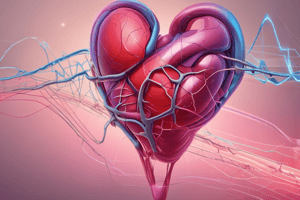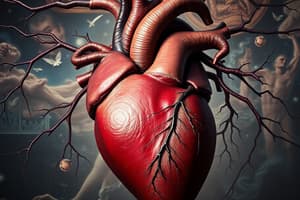Podcast
Questions and Answers
What is the function of the SA node in the electrical conduction system of the heart?
What is the function of the SA node in the electrical conduction system of the heart?
- To repolarize the Purkinje fibers
- To act as the natural pacemaker of the heart (correct)
- To delay the electrical signal between the atria and ventricles
- To transmit the electrical signal from the atria to the ventricles
Which ECG wave represents ventricular depolarization?
Which ECG wave represents ventricular depolarization?
- U wave
- P wave
- T wave
- QRS complex (correct)
What is the normal duration of the PR interval in an ECG?
What is the normal duration of the PR interval in an ECG?
- 120-200 ms (correct)
- 500-600 ms
- 350-450 ms
- 80-120 ms
Which ECG lead records the difference in potential between the left arm and the center of the heart?
Which ECG lead records the difference in potential between the left arm and the center of the heart?
What is the function of the Purkinje fibers in the electrical conduction system of the heart?
What is the function of the Purkinje fibers in the electrical conduction system of the heart?
What is the normal duration of the QT interval in an ECG?
What is the normal duration of the QT interval in an ECG?
What is the purpose of the chest leads V1-V6 in a 12-lead ECG?
What is the purpose of the chest leads V1-V6 in a 12-lead ECG?
What is the significance of a regular rhythm in an ECG?
What is the significance of a regular rhythm in an ECG?
What is the primary application of ECG in physiology labs?
What is the primary application of ECG in physiology labs?
What is the significance of the P wave morphology in an ECG?
What is the significance of the P wave morphology in an ECG?
What is the significance of a heart rate of 110 beats per minute in an ECG?
What is the significance of a heart rate of 110 beats per minute in an ECG?
What is the purpose of the QT interval in an ECG?
What is the purpose of the QT interval in an ECG?
Flashcards are hidden until you start studying
Study Notes
Electrical Conduction System
- The electrical conduction system of the heart consists of:
- SA (Sinoatrial) node: the natural pacemaker, located in the right atrium
- AV (Atrioventricular) node: located between the atria and ventricles
- Bundle of His: a group of specialized fibers that transmit the electrical signal from the AV node to the ventricles
- Purkinje fibers: a network of fibers that transmit the electrical signal to the ventricular myocardium
ECG Waves
- The ECG waveform consists of:
- P wave: represents atrial depolarization
- PR interval: the time between the P wave and the QRS complex, representing the delay between atrial and ventricular depolarization
- QRS complex: represents ventricular depolarization
- ST segment: the period of ventricular contraction
- T wave: represents ventricular repolarization
- U wave: a small deflection that can occur after the T wave, representing the repolarization of the Purkinje fibers
ECG Intervals
- The ECG intervals are:
- PR interval: 120-200 ms (0.12-0.20 seconds)
- QRS duration: 80-120 ms (0.08-0.12 seconds)
- QT interval: 350-450 ms (0.35-0.45 seconds)
- RR interval: the time between two consecutive R waves, representing the heart rate
ECG Axes
- The ECG axes are:
- Lead I: records the difference in potential between the left and right arms
- Lead II: records the difference in potential between the left leg and the right arm
- Lead III: records the difference in potential between the left leg and the left arm
- aVR: records the difference in potential between the right arm and the center of the heart
- aVL: records the difference in potential between the left arm and the center of the heart
- aVF: records the difference in potential between the left leg and the center of the heart
Electrical Conduction System
- SA (Sinoatrial) node is the natural pacemaker, located in the right atrium.
- AV (Atrioventricular) node is located between the atria and ventricles.
- Bundle of His is a group of specialized fibers that transmit the electrical signal from the AV node to the ventricles.
- Purkinje fibers are a network of fibers that transmit the electrical signal to the ventricular myocardium.
ECG Waves
- P wave represents atrial depolarization.
- PR interval is the time between the P wave and the QRS complex, representing the delay between atrial and ventricular depolarization.
- QRS complex represents ventricular depolarization.
- ST segment is the period of ventricular contraction.
- T wave represents ventricular repolarization.
- U wave is a small deflection that can occur after the T wave, representing the repolarization of the Purkinje fibers.
ECG Intervals
- PR interval is 120-200 ms (0.12-0.20 seconds).
- QRS duration is 80-120 ms (0.08-0.12 seconds).
- QT interval is 350-450 ms (0.35-0.45 seconds).
- RR interval is the time between two consecutive R waves, representing the heart rate.
ECG Axes
- Lead I records the difference in potential between the left and right arms.
- Lead II records the difference in potential between the left leg and the right arm.
- Lead III records the difference in potential between the left leg and the left arm.
- aVR records the difference in potential between the right arm and the center of the heart.
- aVL records the difference in potential between the left arm and the center of the heart.
- aVF records the difference in potential between the left leg and the center of the heart.
ECG in Physiology Lab
Introduction
- ECG is a non-invasive test that records the electrical activity of the heart.
- ECG is used in physiology labs to measure heart electrical activity and diagnose cardiac arrhythmias.
Lead Placement
- Standard 12-lead ECG configuration is used in physiology labs.
- Lead placement locations:
- RA (right arm): right wrist
- LA (left arm): left wrist
- RL (right leg): right ankle
- LL (left leg): left ankle
- V1-V6: chest leads, placed on the chest
ECG Components
- P wave: represents atrial depolarization
- PR interval: time between P wave and QRS complex
- QRS complex: represents ventricular depolarization
- ST segment: represents ventricular repolarization
- T wave: represents ventricular repolarization
- QT interval: time between QRS complex and T wave
ECG Analysis
- Heart rate: calculated from the time between QRS complexes
- Rhythm: regular or irregular
- Axis: direction of the heart's electrical activity
- P wave morphology: shape and size of the P wave
- QRS complex morphology: shape and size of the QRS complex
Normal ECG Values
- Heart rate: 60-100 beats per minute
- PR interval: 120-200 milliseconds
- QRS duration: 80-120 milliseconds
- QT interval: 300-450 milliseconds
Common ECG Abnormalities
- Arrhythmias: irregular heart rhythms
- Tachycardia: heart rate > 100 beats per minute
- Bradycardia: heart rate < 60 beats per minute
- Long QT syndrome: prolonged QT interval
ECG Applications
- Cardiovascular disease diagnosis
- Monitoring of cardiac arrhythmias
- Evaluation of cardiac function
Studying That Suits You
Use AI to generate personalized quizzes and flashcards to suit your learning preferences.



